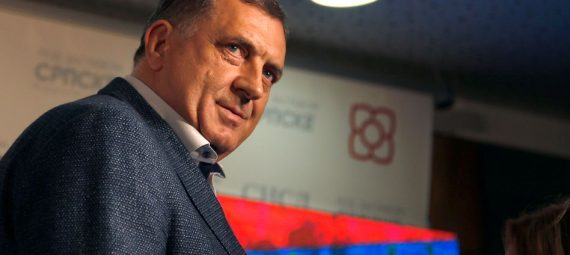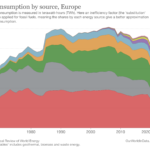Johannes Eber – Good morning Europe blog
When I was in my early twenties, the Bosnian War dominated the daily news. Horrible pictures of people fleeing snipers in Sarajevo, atrocities in Srebrenica.
When peace returned (at least on paper) in the mid-1990s, my attention on the region disappeared. To be honest: Until a few months ago I would probably not have found the Republika Srpska on a nameless map.
Republika Srpska is one of the two entities of Bosnia and Herzegovina, the other is the Federation of Bosnia and Herzegovina (see map below). The region is back in global public because of one man: Milorad Dodik, 62.

Dodik, the region’s leader, a pugnacious Serb nationalist, is threatening to tear the country apart by pulling out of Bosnia’s multi-ethnic armed forces (and form his own exclusively Serb army), state’s tax agency, intelligence service and judiciary.
Why is Dodik promoting the division of the country? The short answer is: Because he can.
Three presidents run the country. The reason: the country is home to three main ethnic groups, designated “constituent peoples” in the country’s constitution, namely the Bosniaks as the largest group of the three, the Serbs as the second-largest, and the Croats as the third-largest.
The three members of the Presidency are elected directly by the people, with Federation voters voting for the Bosniak and the Croat president and the Republika Srpska voters voting for the Serb president. The Chair of the Presidency of Bosnia and Herzegovina rotates among three members (Bosniak, Serb, Croat), each elected as the chair for an eight-month term within their four-year term as a member.
The three presidents are supposed to meet every two weeks to sign off on key proposals. But they have not met since October 2021, when Dodik showed up with an accordion and started singing Serb folk songs in his office with a group of supporters. Since then, he has rejected or ignored all proposals from his fellow presidents.
Why does the government have such a strange structure? Because the country has a horrible past.
The ethnic conflicts sparked the Bosnian war from 1992 to 1995 that killed around 100,000 people and displaced over 2.2 million people.
A brief history lesson.
The war started after the multi-ethnic Socialist Republic of Bosnia and Herzegovina seceded from the Socialist Federal Republic of Yugoslavia (like Slovenia and Croatia had done a year before). A majority of the Serbs didn’t agree with the separation but they were outnumbered since they accounted for just a third of the population.
On 29 February 1992, the country passed a referendum for independence. The political representatives of the Bosnian Serbs boycotted and rejected its outcome.
On 6 March 1992, the Bosnian parliament promulgated the referendum results, proclaiming the republic’s independence from Yugoslavia.
The republic’s independence was recognised by the European Community on 6 April 1992 and by the United States on 7 April. On the same day, the Serbs’ assembly in session in Banja Luka declared a severance of governmental ties with Bosnia and Herzegovina.
Following Bosnia and Herzegovina’s declaration of independence, the Bosnian Serbs, led by Radovan Karadžić and supported by the Serbian government of Slobodan Milošević and the Yugoslav People’s Army, mobilised their forces inside Bosnia and Herzegovina in order to secure ethnic Serb territory, then the war soon spread across the country.
Almost 30 years have passed since then. Probably not long enough for there to be no more tension.
At least in the country’s political structure, the war is still present.
In 1995, in the Dayton Agreement, the warring parties agreed to peace and to a single sovereign state known as Bosnia and Herzegovina composed of two parts, the largely Serb-populated Republika Srpska and mainly Croat-Bosniak-populated Federation of Bosnia and Herzegovina.
This strong regional autonomy may have been the only option at the time. With politicians like Dodik, it is a problem today.
Is a secession or a new war likely? Most experts don’t think so. For two reasons:
First, Dodik is looking for support from “his friends” Russia and nearby Serbia, but it is doubtful whether these states would support him in case of secession.
Second, it can be assumed that his loud rhetoric mainly serves to maintain his power. And his power may have become fragile.
One reason is this: When recently Bosnia’s medicines agency inspected oxygen sold to Republika Srpska’s hospitals to treat Covid-19 patients it made a shocking discovery. The oxygen was meant for use only in industrial machines, not on human beings. Bosnian investigators have traced the oxygen shipments to a company controlled by one of Dodik’s close political allies.
It seems therefore quite possible that Dodik’s secessionist threats are above all to deflect from allegations of corruption. What also suggests that Dodik is primarily interested in votes: the next general elections are just around the corner, they will be held on 2 October 2022.
Author Profile

-
Founder of the "Good morning Europe blog" and Pixel economist
Guest author for European Liberals for Reform
Johannes' articles are originally written for the “Good morning Europe” blog (www.goodmorningeurope.org) and the Pixel economist (https://thepixeleconomist.substack.com).
We were given permission to publish his articles on the European Liberals for Reform blog.
Latest entries
Post Disclaimer
The opinions expressed by the author of this post do not necessarily represent the opinions and policies of ELfR.




